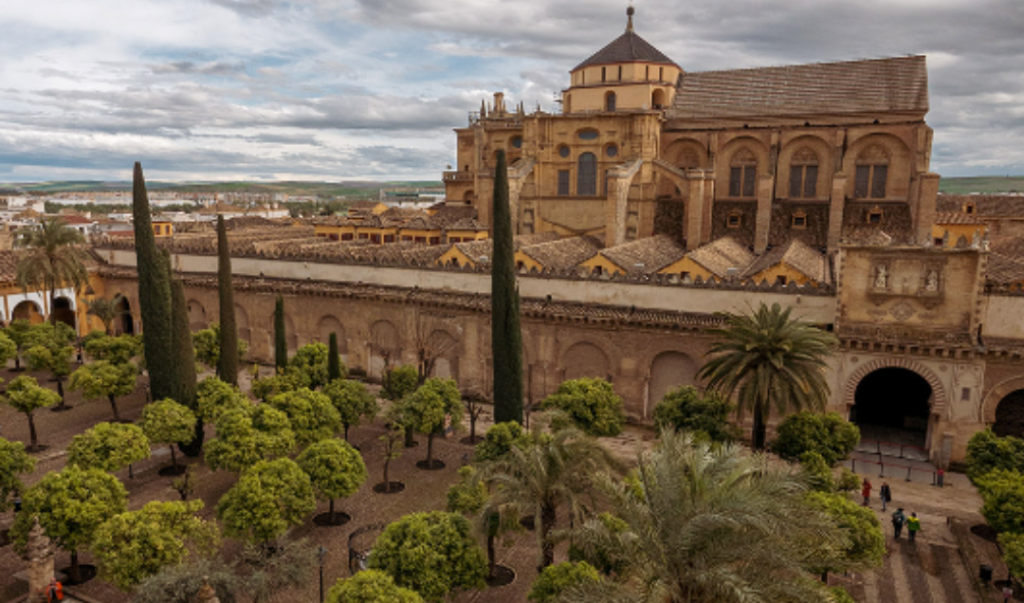Cordoba a land of fascinating history, breathtaking views and a cultural and religious mix. It has a long history which explains the presence of Roman, Muslim and Christian monuments in the city, which one is sure to discover while exploring.
When should one Visit? In the summer, the high temperatures in Córdoba might make it tough to stay inside. The city is one where it can get hot very rapidly. Additionally, the tourist density in the narrow streets can rise quickly. In order to take advantage of the pleasant weather and avoid the crowds, I would thus suggest that you visit in the spring or autumn.
How to get there? Since Córdoba lacks an airport, you must travel there from one of Andalusia’s larger cities. From Seville, it takes 45 minutes, and from Granada, it takes 1.5 hours.
Who is it for? For everyone—couples, friends, families—as long as you value history, as Cordoba’s primary attractions are historical buildings.
How long should one stay? Since Cordoba is a tiny city, a day is sufficient to explore it and include it in a trip to the rest of Andalusia.
How to communicate? You can communicate well in English or by “gabbling” a few Spanish words!
How to commute? Everything is easily accessible on foot, and it takes only 15 minutes to walk from the train station to the city centre, where all the historical buildings are.
We’ve listed below experiences one is sure to explore while discovering the city.
- Stroll around the historic centre
- The Cathedral Mosque
- Alcazar of the Christian Kings of Cordoba
- The Roman Bridge
- Synagogue
Stroll through the Historic Centre
Start your journey around Cordoba by taking a stroll around the streets of historic centre. The cobbled streets lead to beautiful destinations and you never know what you might spot. Considering how small the city is, don’t be concerned if you get lost. You’re likely to find some endearing vistas that are typical of the area if you take the time to meander from one alley to the next.
The Cathedral Mosque
One of the most amazing monuments. One of the most significant religious structures in the entire world is the “Mezquita de Córdoba,” and its intriguing history is one of the reasons why.
This structure served as a mosque from the 8th century until 1236, when Abd al-Rahman I moved into the region. The 16th-century “Capilla mayor,” which appears to be a cathedral placed in the middle of the mosque, is what gives this monument its unusual architecture. Despite the fact that it is referred to be a “mosque-cathedral,” only Catholics are permitted to worship there at this time.
Prices:
€11 for adults
€9 for under 26s
6 € for children under 14
4 € for children under 10
Timings:
From 10am to 2pm and from 4pm to 7pm
Alcazar of the Christian Kings of Cordoba
The Alcázar, which is next to the cathedral, is the other must-see structure in Cordoba. After the Christian reconquest of Cordoba, the Catholic Kings lived in this castle, which was constructed on the remains of the former Moorish citadel. It was a defensive structure.
The Infanta Maria, Queen of Portugal, was born here, and Christopher Columbus met the Spanish kings here in 1492 as he prepared for his first expedition to the Americas.
Prices:
5 € for adults
2.5 € for under 26s
Timings:
Tuesday to Sunday from 8.45 am to 3.15 pm
The Roman Bridge
This Roman bridge, sometimes referred to as the “old bridge,” was the only one in Cordoba for twenty centuries after it was constructed over the Guadalquivir. The bridge was constructed around the start of the first century under the reign of the Romans, and it was restored by the Moorish Caliphs in the tenth century. Thereafter, it underwent a number of restorations.
Its enormous design is not without beauty, and some of the Game of Thrones series filmmakers even fell for it when filming some of its scenes here.
Synagogue
The Synagogue is one of just three well-preserved mediaeval synagogues in all of Spain and is located in the centre of Cordoba’s Jewish Quarter. It is also unique to Andalusia. It was constructed during the years of 1314 and 1315, based on inscriptions discovered inside the structure, and it was continuously occupied up until the Jews were finally driven out of Spain. An intimate patio leads to a constrained foyer. The women’s portion is accessible through a stairway on the right, and the main hall, which is rectangular in shape and painted with plant motifs in the Mudejar style, is in front. Three arches on the wall that supports the women’s tribune feature excellent ornamental plasterwork. At the conclusion of the 19th century, it was designated a National Monument.
Prices:
Free Entry
Timings:
Monday to Sunday from 9 am to 9 pm

